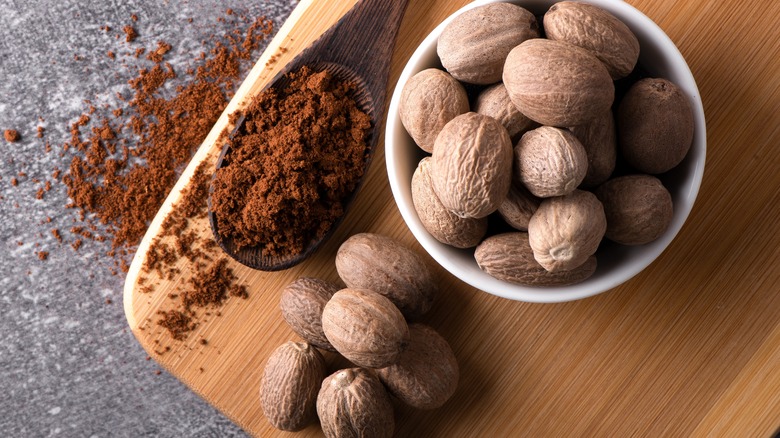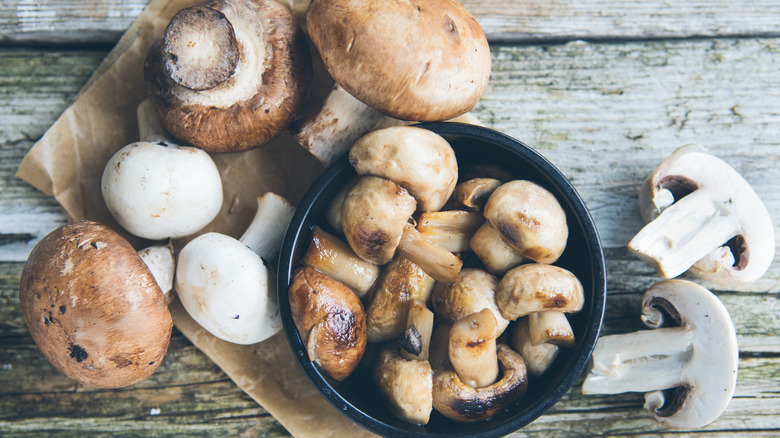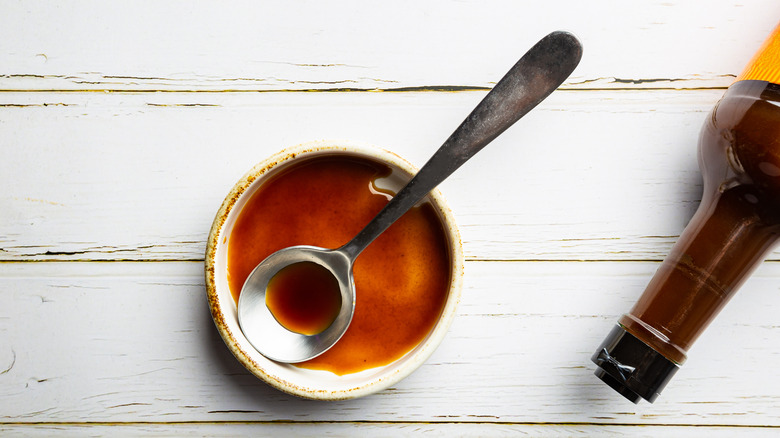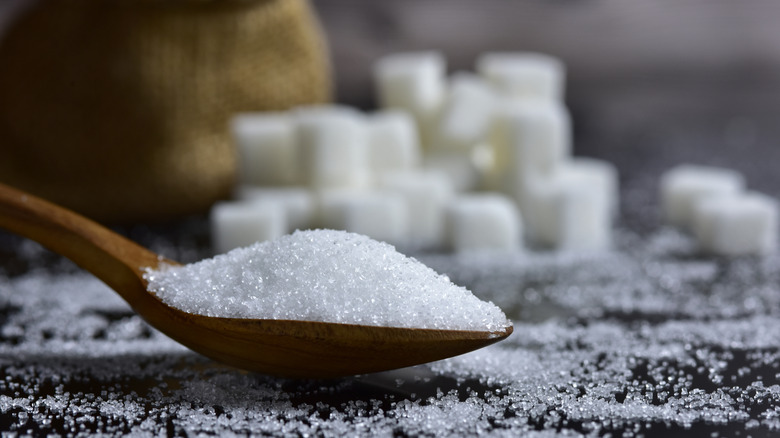14 Mistakes Everyone Makes When Cooking Breakfast Gravy
We really love breakfast gravy, guys — and we're not the only ones. This smooth, velvety combination of sausage and a flour-thickened milky sauce is one half of biscuits and gravy, the Southern staple that has graced breakfast tables since the late 1800s. What looks like a basic combo of meat and gravy, however, can be mind-bogglingly difficult to get right. There's a surprisingly high margin of error when making breakfast gravy, and getting it wrong with some rookie errors is all too common.
Breakfast gravy's short ingredients list means that you need to ensure that every component is handled just right, otherwise, your errors become even more obvious. Take the sausage, for example: It's not enough to just throw it in the pan and hope for the best. Fail to brown it properly, use the wrong type of sausage, or mash it too vigorously, and you're in for a disappointing breakfast lacking in flavor and with a poor texture. The gravy, meanwhile, may cook quickly, but treat your flour poorly or fail to season it properly, and you're left with a lumpy, tasteless mess.
1. Mistake: Using poor-quality sausage
Your sausage will take up a large proportion of your gravy's flavor profile and fill it with salty, savory notes. It also adds the much-needed bite that prevents this gravy from becoming gloopy and insipid. Unfortunately, too many people think that they can expect good results from poor products; often, they'll use a poor-quality or cheap sausage in their gravy — and are then surprised when it doesn't taste good.
As such, you'll want to use the best-quality sausage you can find. Avoid low-cost options, which will frequently be bulked out with filler ingredients and get their flavor from additives or high levels of salt. Look for sausage blends that contain at least 60% meat and get their flavor from well-chosen herbs and spices. If you live near a butcher, it's always a good idea to buy your sausage from there, as you'll be able to better discern where it comes from and what's in it by talking to the store staff. If you're up to it, though, you can always make your own! Super pork sausage can be made in mere minutes by grinding pork shoulder and mixing it with a variety of readily-available seasonings.
2. Mistake: Mashing your sausage up into tiny pieces
Making a classic one-skillet sausage gravy takes a few easy steps, but one of the most important and poorly-executed ones is mashing your sausage. Once the meat is thrown into the pan, it's pretty easy to start going wild and breaking it up into ever-smaller pieces in the hopes that it'll brown better. Well, doing this may give you some delightfully crispy smaller pieces, but it will also leave your teeth with nothing to get into.
The key to avoiding this is to hold back. Mash your sausage way less than you think, and leave chunky, larger pieces that will be satisfying to bite into. If you find that the pieces are too big before adding the rest of the ingredients you can always mash them further — but you can't put them back together once they've started to brown.
A good way to break up your sausage quickly is by using a potato masher. Just press it on top of your sausage as it cooks and it will flatten it, making it easier to separate the meat. Just remember, though, that you'll only want to press it lightly a few times to prevent it from breaking apart too much.
3. Mistake: Failing to brown your sausage properly
If you're not browning your sausage properly, you're not making breakfast gravy right. Browning any kind of meat deepens and develops its flavors through the Maillard reaction. This chemical reaction causes the sugars and amino acids in your sausage to react with one another when dry heat is applied, giving its surface a deeper color and unlocking sweet, savory, salty notes in the meat. However, fail to cook your sausage for long enough, apply enough heat, or keep the pan sufficiently dry, and your browning process will be ruined.
To nail the browning process, you'll need three things: time, heat, and space. Use a big enough pan to stop the sausage pieces nudging up against each other, as this will cause them to produce steam and prevent them from browning. Make sure your pan is hot enough, but not too hot: You want your sausage pieces to brown, not sear and burn. Finally, give them a good amount of time to sizzle, stirring them occasionally so that every side of the sausage browns for maximum flavor.
4. Mistake: Over-seasoning your gravy
We all want our sausage gravy to have flavor, but it's a pretty delicate balance. One of the biggest mistakes when it comes to homemade sausage gravy is over-seasoning it, and adding in way too much salt, pepper, and additional flavors. By doing this, you muddy the flavor of your gravy, adding unnecessary complexity and saltiness to it that is difficult to rectify, and leaving you with an overpowering flavor that's not exactly pleasant to eat at breakfast.
It's worth remembering that sausage meat is often heavily pre-seasoned, and adding more flavor to the gravy before it's had a chance to fully release its seasonings into the liquid will ruin things. The best thing to do is to give your gravy time. Avoid tasting it too much as it's cooking, as this can tempt you to add salt, pepper, herbs, and spices in before the flavor has had time to blossom. Once it's almost ready, do a taste test, and add in any seasonings you need to. Try not to do this randomly, though: Throwing in spices and herbs that contrast the flavor profile of your sausage will lead to a clash and a strange-tasting dish.
5. Mistake: Not whisking it enough
There are good and bad kinds of lumps in sausage gravy. The good kinds are the lumps made out of nuggets of salty, savory sausage meat. The bad kinds are the lumps made from flour, that haven't incorporated properly with the milk. Unfortunately, these lumps often occur when you fail to whisk your gravy sufficiently, which stops them from breaking up properly and creating a smooth, luscious sauce.
To prevent this, you need a whisk. A whisk is most useful when you're removing your sausage pieces before adding your flour, which we'd always recommend doing, to give your gravy a smoother consistency. Once you've cooked the raw flour taste away, whisking the dry flour constantly in the sausage drippings, add your milk a little at a time, whisking constantly to incorporate the two. Avoid dumping all of your milk in at once: This will make it harder for the flour to thicken the sauce smoothly and seamlessly. Once your gravy is velvety and rich, with no sign of lumps, then you can add your sausage pieces back in. If you're worried about scratching the bottom of your pan with your whisk, use a silicone or rubber model -– but bear in mind that these can bend quite easily.
6. Mistake: Adding too much milk
It's likely that you don't need as much milk as you think you do in breakfast gravy. Adding too much is one of the cardinal sins when it comes to making breakfast gravy, and leads to the whole affair being thin, runny, and tasteless. As your milk is generally the last thing you add to the pan (apart from any additional seasonings), if you pour in too much, it can be difficult to thicken it back up. Add more flour, and it will have a tough time incorporating, leading to chalky deposits in your gravy. Simmer it to reduce the gravy, meanwhile, and you may end up overcooking everything, burning the sauce or making your sausage pieces rubbery and tough.
Rather than risk any of these mishaps, you need to remember the key ratio. Work on a 3:2:1 ratio of flour, to fat, to liquid – so for every 3 tablespoons of flour you use, you should have 2 tablespoons of fat, and 1 cup of milk. It's always a good idea to keep a little extra milk on hand in case your gravy is too thick, but only add it once it's fully thickened.
7. Mistake: Forgetting to add herbs
Forget to add herbs to your breakfast gravy, and you're missing out on a golden opportunity. Herbs add an all-important lightness to breakfast gravy that prevents it from tasting too heavy and claggy. Whether you're going for fresh or dried herbs, they can infuse your gravy with a gently floral aroma and a zingy taste that cuts through its savoriness.
Making a herbed sausage gravy is as simple as adding in your herbs of choice. The often-underappreciated sage is a perfect option here, adding a woody, almost smoky layer to your pork and filling out the flavor of the gravy excellently. Parsley is also a great choice, giving it a bright, peppery note and helping to contrast the dense sausage with some freshness. Thyme and oregano can also be good options, the former for its almost perfumed aroma and the latter for its sunny Mediterranean notes. If you're using fresh herbs, remember to keep a small handful to the side to garnish your biscuits and gravy at the end. If using dried, ensure that they have at least a few minutes to cook into your gravy, so you get the most from their flavor.
8. Mistake: Using too much fat
There's usually a fair amount of fat in breakfast gravy, which comes from the sausage, milk, and oil or butter you use to cook the meat in. This fat gives your gravy its creaminess and rich flavor, and helps to amplify the savory notes in the dish. However, too much fat can be a bad thing, as it can cause the gravy to split, with pools of unincorporated grease sitting on top of or inside your mixture, ruining its flavor and texture.
The best thing to do is to add your fat sparingly at the beginning. Try to add just enough to grease your pan, so that your sausage doesn't stick when you start to fry it. Remember that it will release fat as it fries, adding even more to your pan. If you do have too much fat in your skillet, simply spoon some out before you add your flour. Don't remove too much of it, though: You'll need roughly 2 tablespoons of fat for every 3 tablespoons of flour that you have, and trying to cook the flour in less than that can cause it to stick to the pan or scorch.
9. Mistake: Skipping the nutmeg
Breakfast gravy doesn't need a lot to make it pop — but what it does need is nutmeg. This unexpected spice provides bold new flavor to breakfast gravy, with its woody intensity giving the dish a lot of complexity. Where nutmeg particularly shines in sausage gravy is in its ability to not just round out the flavor of the meat, but provide depth to the dairy flavors; this prevents everything from tasting too creamy and rich, but doesn't get in the way of them.
When adding nutmeg, though, remember that it's best to err on the side of caution. It can quickly overpower any other flavor in your dish, with its spiciness turning from warm to fiery in an instant. It's best to use just a pinch and give it a few minutes to diffuse through the gravy before adding more, if necessary. Keep in mind, too, that freshly-grated nutmeg will usually be stronger than store-bought ground nutmeg, as it has more of its oils. As such, if you're using the freshly-grated kind, you may need to use it a little more sparingly.
10. Mistake: Forgetting about your veggies
Classic breakfast gravy is pretty simple, with sausage being its main component. While this can be satisfying, too many people forget that vegetables can brighten it up enormously. By adding in veggies, you not only make your breakfast gravy feel more nutritious and healthy, but you also bulk it out more in a cost-effective way, meaning you have more to go around without breaking the bank. Vegetables also add a huge amount of flavor, giving it more depth, savoriness, and nuttiness (depending on what you choose).
Although you can, in theory, toss any vegetables you want into breakfast gravy, certain types will work better than others. It's hard to go wrong with mushrooms and onions, both of which pair beautifully with sausage and give the dish a sharpness and umami notes. Just throw them in a few minutes after you add your sausage to the pan and brown them before you add the other ingredients. Chopped carrots, eggplant, and zucchini are also great options, and give your gravy a pop of brightness. If you want some greenery, throw in some regular or sugar snap peas, which will also provide a slightly crunchier texture.
11. Mistake: Trying to rush your gravy
The beauty of breakfast gravy is that it delivers complex flavors to your morning table pretty quickly. However, you shouldn't assume that it's instant. Making breakfast gravy is composed of two key stages: the browning of your sausage, and the thickening of your gravy. Rush either of these, and you'll end up with a flat-tasting, thin gravy that is full of lumps of flour and grey blobs of meat.
So, give yourself enough time to cook it properly. You'll generally need about 5 to 7 minutes to brown the sausage thoroughly, with a little more time required if you're making a big batch. You'll also need around 10 to 15 minutes to thicken the gravy properly. Remember that gravy thickens slowly, and if you try to rush things, you won't give the flour enough time to cook into the liquid and absorb it sufficiently. Don't be tempted to turn the heat up to rush things, either. Doing this when you're cooking your flour can burn it, leaving your gravy tasting acrid and charred. Trying to speed things along by cranking up the heat while your gravy's thickening may cause it to scorch on the bottom of the pan.
12. Mistake: Opting not to include Worcestershire sauce
Worcestershire sauce makes pretty much anything better, and it helps breakfast gravy enormously. This fish-based sauce adds a huge amount of umami instantly and it pairs excellently with the flavors of your sausage. Unfortunately, a lot of folks forget that this much-loved condiment is a natural fit for breakfast gravy, and leave it on the shelf –- then wonder why their gravy tastes flat and boring.
So, don't forget to add a few dashes into your homemade gravy. Worcestershire sauce adds not just savoriness, but sweetness and a touch of acidity, providing your gravy with a more rounded taste. It also helps to deepen the color of your liquid, giving it a golden tinge.
As with most things in the kitchen, though, you can overdo things quickly. Adding too much Worcestershire sauce can mask your sausage's inherent flavors and make your gravy taste a little sickly and weird. As such, save adding it until the end, sprinkling in a dash or two, stirring the gravy thoroughly, and tasting it before adding any more.
13. Mistake: Forgetting to add sugar
Sugar doesn't often feature on breakfast gravy recipe ingredients lists, but it really should. A sprinkle of sweetness is often what's missing, and by failing to add it, you can be left with a meal that's relentlessly savory and salty. It's important to remember that adding sugar won't make your gravy taste sweet; instead, it will round out its flavor, helping to pull back on the salty, umami notes, and giving it a taste that develops on the tongue.
When adding sugar, though, it's all about balance. Too little, and you might as well not have added any; too much, and your gravy will taste like pudding. The key is to add it sparingly, a pinch at a time. Once you add your sugar, make sure you stir it through thoroughly, giving it a minute or two to distribute its flavors through the gravy, before tasting and adding more if necessary. You don't have to be fancy with the type of sugar you add — plain white granulated sugar will do just fine — but if you want to add extra flavor dimensions, use a squeeze of honey or some dark muscovado sugar.
14. Mistake: Sticking to your method too rigidly
Breakfast gravy is one of those dishes that you can make in many different ways, and opting for a different method unlocks different flavors and nuances in your dish. One way to mix things up is by altering the way you make your roux. While you might be used to just sprinkling flour onto your sausage pieces, cooking it slightly, and then adding milk (which is definitely a speedy option), removing your meat and cooking the flour without anything else in the pan can give the gravy added nuttiness and depth.
Remember, too, that you don't have to stick to the same ingredients every time. If you want added richness, use half and half instead of regular milk. If you're craving a little spice, opt for hot Italian sausage instead of your regular link sausages. Want a bit more umami punch? Throw in a clove or two of garlic. You have endless choices when it comes to breakfast gravy, and failing to explore them will make it pretty boring.














